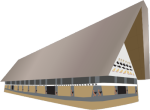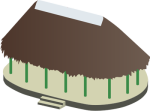Top ten human symbols: People, buildings and boats
Bill Dennison ·This is the sixth and final blog post in a series which celebrates the IAN symbol library by highlighting some of the most interesting symbols. Previous blog posts have focused on marine flora and fauna, birds, trees and animals. This blog post focuses on human aspects, with human structures and people themselves.
![]() 1. The symbol of a teacher reflects one of the developments of the IAN symbol library. The first two thousand symbols created for the symbol library were of plants, animals, processes and seascapes and landscapes. Even though there were symbols depicting human built structures, there were no symbols of humans. As IAN developed a broader purview and accepted the challenge of communicating various socio-economic issues in addition to natural science issues, the need for human symbols increased. The Science Communicator willing to undertake this challenge was Tracey Saxby.
1. The symbol of a teacher reflects one of the developments of the IAN symbol library. The first two thousand symbols created for the symbol library were of plants, animals, processes and seascapes and landscapes. Even though there were symbols depicting human built structures, there were no symbols of humans. As IAN developed a broader purview and accepted the challenge of communicating various socio-economic issues in addition to natural science issues, the need for human symbols increased. The Science Communicator willing to undertake this challenge was Tracey Saxby.
 2. The symbol of an East African woman hauling bags of seaweed was developed in Zanzibar, where the IAN team visited in 2010. There is an active seaweed farming program on the east coast of the island of Zanzibar, which is just off the coast of Tanzania on the Indian Ocean. The women walk out onto the extensive tidal flats during low tide to plant, maintain and collect the red algae. This algae is a rich source of carrageenan, a polysaccharide that is used in food preparation as an emulsifier. The bags of wet seaweed are very heavy, which the women carry atop their heads, depicted in this symbol. The seaweed is spread out to dry in the sun and then shipped off for carrageenan extraction. This symbol was drawn by Tracey Saxby.
2. The symbol of an East African woman hauling bags of seaweed was developed in Zanzibar, where the IAN team visited in 2010. There is an active seaweed farming program on the east coast of the island of Zanzibar, which is just off the coast of Tanzania on the Indian Ocean. The women walk out onto the extensive tidal flats during low tide to plant, maintain and collect the red algae. This algae is a rich source of carrageenan, a polysaccharide that is used in food preparation as an emulsifier. The bags of wet seaweed are very heavy, which the women carry atop their heads, depicted in this symbol. The seaweed is spread out to dry in the sun and then shipped off for carrageenan extraction. This symbol was drawn by Tracey Saxby.
 3. The symbol of a bai, which is a thatched roof, open air meeting house in Palau was created by Jane Thomas during our visit to Palau in 2007. These buildings were beautifully decorated with 'storyboards' which used various symbols to depict historic events (many were X-rated). Apart from the content, the Micronesian storyboards were remarkably similar to the conceptual diagrams that IAN develops through their use of universal, easily recognizable symbols. The bai structure was used for community meetings and to settle disputes and negotiate various interactions between different groups. A tribal leader would sit in one of the four corners of the bai and his assistants would act as go betweens with the other leaders in the other corners.
3. The symbol of a bai, which is a thatched roof, open air meeting house in Palau was created by Jane Thomas during our visit to Palau in 2007. These buildings were beautifully decorated with 'storyboards' which used various symbols to depict historic events (many were X-rated). Apart from the content, the Micronesian storyboards were remarkably similar to the conceptual diagrams that IAN develops through their use of universal, easily recognizable symbols. The bai structure was used for community meetings and to settle disputes and negotiate various interactions between different groups. A tribal leader would sit in one of the four corners of the bai and his assistants would act as go betweens with the other leaders in the other corners.
 4. One of the most iconic buildings in the world is the Sydney Opera House, located on Sydney Harbour, Australia. It was designed by a Danish architect, Jorn Utzon, to look like white sails on a ship in the harbor. The roof is composed of thousands of small white tiles. I wrote a previous blog about a light show that made the Opera House a variety of different colors during a festival in Sydney. This symbol was drawn by Tracey Saxby.
4. One of the most iconic buildings in the world is the Sydney Opera House, located on Sydney Harbour, Australia. It was designed by a Danish architect, Jorn Utzon, to look like white sails on a ship in the harbor. The roof is composed of thousands of small white tiles. I wrote a previous blog about a light show that made the Opera House a variety of different colors during a festival in Sydney. This symbol was drawn by Tracey Saxby.
 5. Another globally iconic building is the United States Capitol Building. Building codes restricting high rises in Washington, D.C., in combination with it being sited on 'Capitol Hill' insures that it is readily visible throughout downtown Washington. The dome was finished during the Civil War and the Capitol now has a relatively new visitor center. This symbol was drawn by Jane Hawkey.
5. Another globally iconic building is the United States Capitol Building. Building codes restricting high rises in Washington, D.C., in combination with it being sited on 'Capitol Hill' insures that it is readily visible throughout downtown Washington. The dome was finished during the Civil War and the Capitol now has a relatively new visitor center. This symbol was drawn by Jane Hawkey.
 6. The Samoan fale is another open air structure, very common throughout Samoa. It serves as the living room and family room for Samoan families. The open sides allow for cooling breezes to waft through, and the sleeping rooms and kitchens are in smaller separate buildings. When visiting Samoa, we saw fales used as school classrooms and family gathering places and we had the pleasure of listening to beautiful singing from church groups emanating from fales. This symbol was drawn by Tracey Saxby.
6. The Samoan fale is another open air structure, very common throughout Samoa. It serves as the living room and family room for Samoan families. The open sides allow for cooling breezes to waft through, and the sleeping rooms and kitchens are in smaller separate buildings. When visiting Samoa, we saw fales used as school classrooms and family gathering places and we had the pleasure of listening to beautiful singing from church groups emanating from fales. This symbol was drawn by Tracey Saxby.
 7. The working crab boat being driven by a Chesapeake Bay waterman is a typical sight during Chesapeake summers. The roof over the back deck provides shelter from the blazing summer sun and thunderstorms. There are steering controls on the back deck so the waterman can tend his crab pots without leaving the deck. The boats are typically painted white. One of the most amazing displays of seamanship can be observed during various festivals around the Bay when watermen will race to dock their boats. The sight of a watermen's boat backing into a pier at full throttle, and then throwing the motor into full ahead to stop the boat inches from the bulkhead is both frightening and exhilarating. This symbol was created by Jane Thomas.
7. The working crab boat being driven by a Chesapeake Bay waterman is a typical sight during Chesapeake summers. The roof over the back deck provides shelter from the blazing summer sun and thunderstorms. There are steering controls on the back deck so the waterman can tend his crab pots without leaving the deck. The boats are typically painted white. One of the most amazing displays of seamanship can be observed during various festivals around the Bay when watermen will race to dock their boats. The sight of a watermen's boat backing into a pier at full throttle, and then throwing the motor into full ahead to stop the boat inches from the bulkhead is both frightening and exhilarating. This symbol was created by Jane Thomas.
 8. The depiction of a house with its attached septic system demonstrates the power of using a realistic graphic that allows insights that a photograph would not be able to capture. Since septic tanks and the associated leach field are buried underground, they are out-of-sight and typically out-of-mind (until they are failing). There is a major ongoing communication challenge to make people aware that even well maintained septic systems do not effectively remove nutrients which enter the shallow groundwater and eventually enter the waterways, contributing to eutrophication. This symbol was created by Jane Thomas.
8. The depiction of a house with its attached septic system demonstrates the power of using a realistic graphic that allows insights that a photograph would not be able to capture. Since septic tanks and the associated leach field are buried underground, they are out-of-sight and typically out-of-mind (until they are failing). There is a major ongoing communication challenge to make people aware that even well maintained septic systems do not effectively remove nutrients which enter the shallow groundwater and eventually enter the waterways, contributing to eutrophication. This symbol was created by Jane Thomas.
 9. The totem pole is an iconic symbol of First Nations (Canada) or Native Americans (U.S.) common in the Pacific Northwest. Totem poles are typically made using red cedar tree trunks which decay slowly. They can depict different animals and different clan symbols. I enjoyed the intricate totems made by the Haida people in Southeast Alaska, particularly at the Totem Park in Sitka. This symbol was created by Tracey Saxby.
9. The totem pole is an iconic symbol of First Nations (Canada) or Native Americans (U.S.) common in the Pacific Northwest. Totem poles are typically made using red cedar tree trunks which decay slowly. They can depict different animals and different clan symbols. I enjoyed the intricate totems made by the Haida people in Southeast Alaska, particularly at the Totem Park in Sitka. This symbol was created by Tracey Saxby.
 10. The IAN symbol library has several symbols of various satellites, which are used to collect various environmental data about the earth. Different satellites carry different sensors which are increasingly used to monitor features such as land use change, sea surface temperature, precise sea levels, fine scale topography, vegetation status, and ocean color. Since satellites are rarely visible with the naked eye, yet so important in data gathering, the symbols are often used in conceptual diagrams to connect the landscape or seascape features with the data gathering approach. This symbol was created by Tracey Saxby.
10. The IAN symbol library has several symbols of various satellites, which are used to collect various environmental data about the earth. Different satellites carry different sensors which are increasingly used to monitor features such as land use change, sea surface temperature, precise sea levels, fine scale topography, vegetation status, and ocean color. Since satellites are rarely visible with the naked eye, yet so important in data gathering, the symbols are often used in conceptual diagrams to connect the landscape or seascape features with the data gathering approach. This symbol was created by Tracey Saxby.
About the author
Bill Dennison

Dr. Bill Dennison is a Professor of Marine Science and Vice President for Science Application at the University of Maryland Center for Environmental Science.

